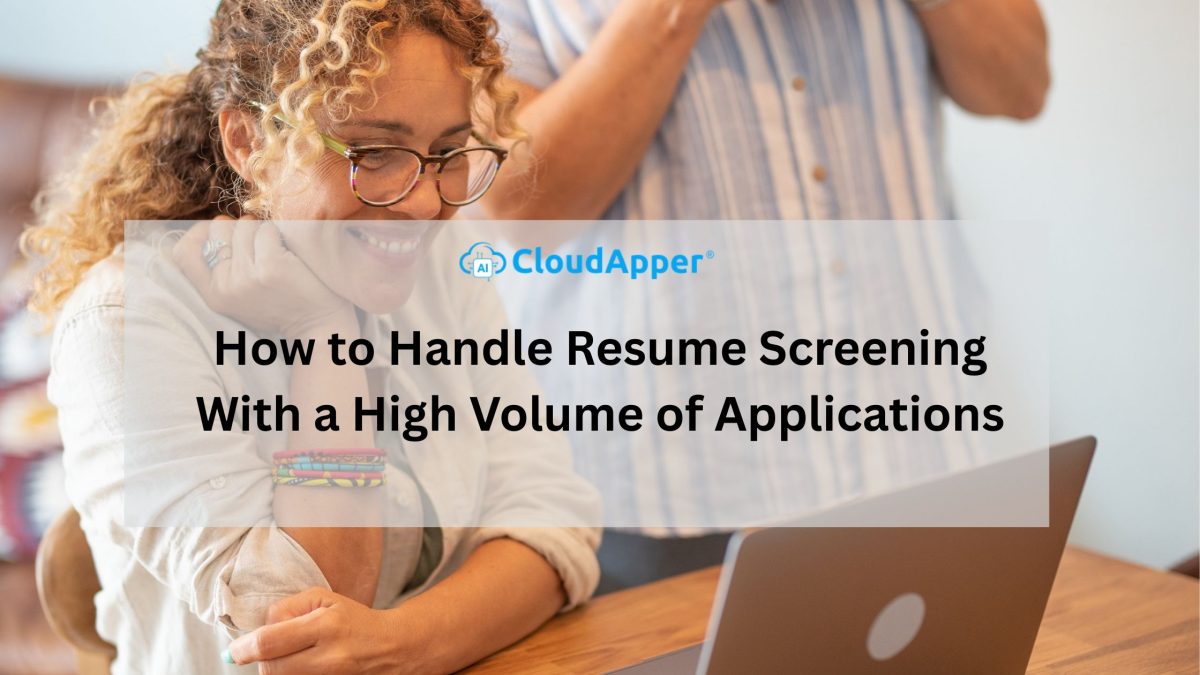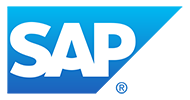Screening hundreds of resumes is tough—but it doesn’t have to be. Discover practical strategies and proven tools, including CloudApper AI Recruiter, to streamline high-volume resume screening with speed, accuracy, and fairness. Save time, reduce errors, and identify top talent effortlessly—even under tight deadlines.
Table of Contents
“Shockingly, employers receive on average 250 resumes per job opening—and only 2% of applicants are ever interviewed.”
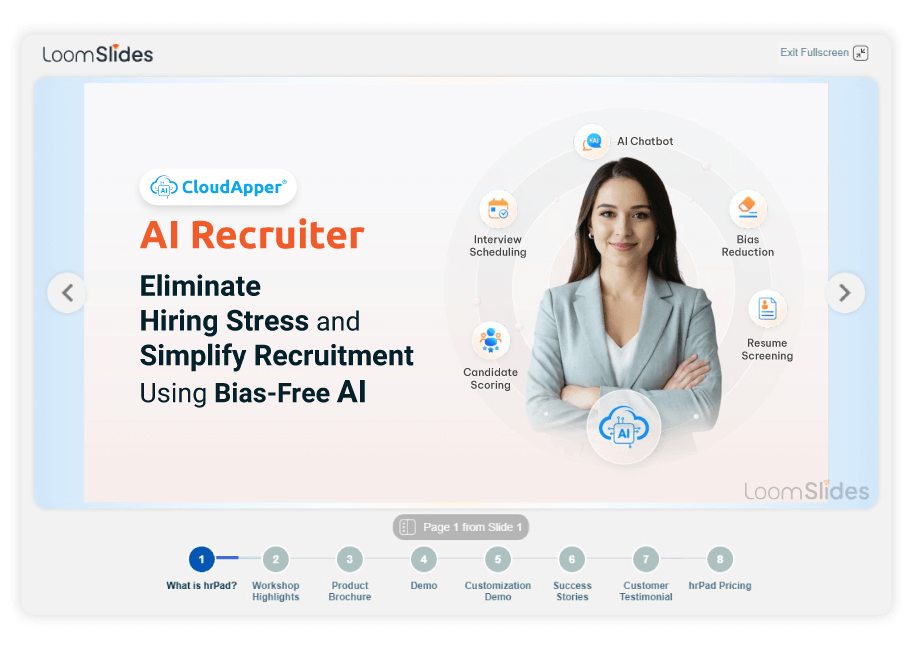
For more information on CloudApper AI Recruiter visit our page here.
I’ve screened thousands of resumes as an experienced talent acquisition professional, first by hand and later with tools. I’ll discuss straightforward, doable methods in this post for handling the screening of a large number of resumes fairly, quickly, and accurately. Additionally, I’ll explain how the CloudApper AI Recruiter improves the procedure, particularly in situations where there is no room for error and time is of the essence.
What is resume screening?
The first step in the hiring process is screening resumes to find applicants who fit essential job requirements like education, experience, and skills. This step is crucial because you could lose your best talent if you overlook any of the hundreds of resumes submitted for a single position.
Why is resume screening hard with hundreds of applications?
Here’s why resume screening becomes especially difficult when you’re dealing with hundreds—or even thousands—of applications for a single role. The volume not only overwhelms your time and capacity but also exposes your hiring process to critical gaps that can affect quality and fairness. Let’s break down the core challenges:
- Time pressure: Recruiters spend just ~6–8 seconds per resume—while 90% of resumes don’t make it past ATS.
- Human inconsistency: Evaluations vary—sometimes based on biases or fatigue.
- Risk of errors: With manual processes, qualified candidates slip through or unqualified ones get through.
What to look for when screening a high volume of resumes
When you’re facing a stack of hundreds of resumes, efficiency matters—but so does accuracy. Over the years, I’ve learned to focus on a few high-impact criteria that help identify top candidates quickly without missing potential gems. Here’s what to prioritize when screening a high volume of resumes:
- Relevant work experience: Similar industries, roles.
- Key skills and competencies: Must match the job requirements.
- Education and certifications: Only if critical to the role.
- Career progression: Evidence of growth or increasing responsibility.
- Formatting & clarity: Easy to scan and understand.
- Red flags: Gaps, exaggerations, unprofessional email addresses.
Best practices for high-volume screening
When you’re handling hundreds—or even thousands—of resumes, relying on intuition alone won’t cut it. Over the years, I’ve developed a systematic approach that not only speeds up the screening process but also improves the quality of hires. Below are 10 best practices I personally follow to handle high-volume resume screening effectively:
1. Define screening criteria upfront
Clearly define the essentials. I always start by outlining the necessary education, years of experience, and abilities. Alignment with hiring managers is thus guaranteed.
2. Use structured scoring
Give each requirement a point value. I used a 0–3 scale for each criterion in a recent position, and resumes with a total score of 18+ were shortlisted. This prevents rash decisions.
3. Leverage ATS filters and Boolean strings
Pre-filter resumes using ATS search strings. For example: (“Python” OR “Java”) AND (“AWS” OR “Azure”)—cuts down the pile before manual review.
4. Apply blind screening
To lessen prejudice, redact names and schools. I once found that shortlisted candidates were 20% more diverse when these fields were removed.
5. Automate knockout questions
Include a question like “Do you have 3+ years in B2B SaaS?” during application. Pre-screens often reduce volume by 30%.
6. Use resume parsing tools
Parsing software helps you search and compare more quickly by extracting structured data. For instance, CloudApper’s parser divides resumes into fields that are simple to score.
7. Prioritize with ranking algorithms
CloudApper AI Recruiter uses your criteria to instantly rank candidates—saving me hours and highlighting the top 10%.
8. Validate resume claims
Leverage AI tools to flag inconsistencies or missing details. In my experience, this helped identify 15% of resumes with inconsistencies.
9. Automate scheduling
Rather than emailing back and forth, have candidates self-schedule once they’re qualified—saving time and improving candidate experience.
10. Review metrics and refine
Track conversion rates, dropout points, and quality-of-hire. I once cut screening time by 50% after adjusting my 20-criteria checklist based on data.
How CloudApper AI Recruiter helps
Here’s where technology truly changes the game. After years of manually sifting through resumes and testing various tools, I’ve found that CloudApper AI Recruiter stands out—not just for speeding things up, but for improving consistency, accuracy, and candidate experience. If you’re overwhelmed by high application volume, here’s exactly how CloudApper helps streamline the entire resume screening process:
- Scales to volume: Instantly parses and ranks hundreds of resumes.
- Error reduction: Uses consistent logic—no fatigue, no bias.
- Integration-friendly: Plug into UKG, Workday, Lever, Greenhouse, BambooHR, and more.
- Conversational pre-screening: Chatbot asks key questions, verifies availability, skills, and salary expectations.
- Seamless ATS sync: Ranked candidates move back into your ATS with notes.
- Automated scheduling & offers: Candidates self-schedule interviews and receive offer letters automatically.
- Transparent reporting: Audit logs track every decision, ideal for compliance and audit purposes.
In my experience, CloudApper reduced initial screening time by 70% and slashed errors by half—a game-changer during tight deadlines.
Sample Screening Efficiency Table
Here’s a quick comparison that shows just how much time you can save by automating your screening process. Based on my experience using CloudApper AI Recruiter, these numbers highlight the efficiency gains across key hiring tasks when switching from manual to AI-assisted methods:
| Task | Manual Avg. Time | With CloudApper AI |
| Resume parsing & scoring | 5 min | 10 sec |
| Initial shortlist (250 resumes) | ~20 hours | ~15 minutes |
| Scheduling 50 screened candidates | ~10 hours | ~30 minutes |
FAQ
Q1: Can AI miss good candidates?
A: AI follows your defined criteria. Stay involved—review shortlists—but AI covers the bulk, not all human insight.
Q2: How accurate is AI ranking?
A: AI ranking aligns 90–95% with experienced human scorers. Continuous calibration ensures quality.
Q3: Will candidates notice the chatbot?
A: Yes—and they like it. Engagement increases and drop-off decreases when the process is fast and responsive.
Q4: Is integration with ATS difficult?
A: No. CloudApper’s API-first design ensures frictionless sync with leading HCM and ATS systems in hours.
Q5: How do you ensure fairness?
A: AI anonymizes candidate data and applies equal criteria to everyone. We track diversity metrics to ensure impact.
Final thoughts
Resume screening at scale doesn’t have to be overwhelming or error-prone. By combining structured criteria, smart automation, and tools like CloudApper AI Recruiter, you can screen hundreds or thousands of resumes with speed, accuracy, and equity. You’ll build reliable pipelines, reduce hiring risk, and win back time to focus on strategic interviewing.
Ready to see CloudApper AI Recruiter handle your high-volume screening needs? Learn more or request a demo.
What is CloudApper AI Platform?
CloudApper AI is an advanced platform that enables organizations to integrate AI into their existing enterprise systems effortlessly, without the need for technical expertise, costly development, or upgrading the underlying infrastructure. By transforming legacy systems into AI-capable solutions, CloudApper allows companies to harness the power of Generative AI quickly and efficiently. This approach has been successfully implemented with leading systems like UKG, Workday, Oracle, Paradox, Amazon AWS Bedrock and can be applied across various industries, helping businesses enhance productivity, automate processes, and gain deeper insights without the usual complexities. With CloudApper AI, you can start experiencing the transformative benefits of AI today. Learn More
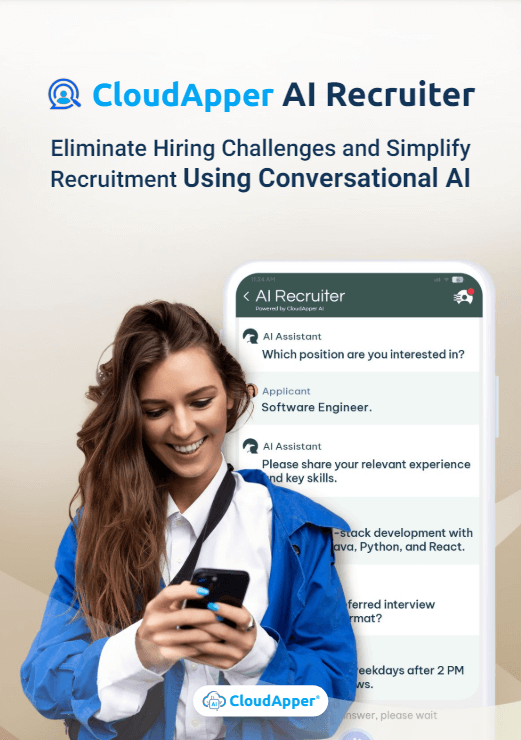
CloudApper AI Solutions for HR

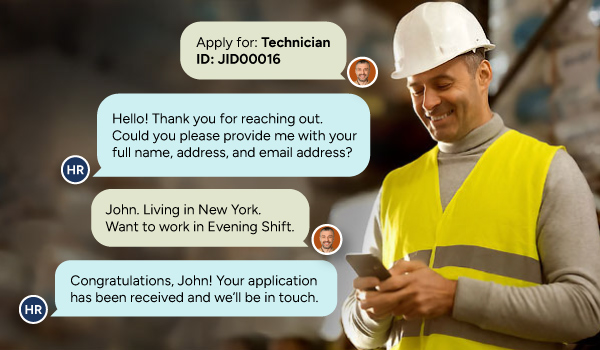

- Works with
- and more.
Similar Posts

How to Use AI in Recruiting: A Complete Guide for…

10 Essential Registered Nurse (RN) Interview Questions to Ask (And…

